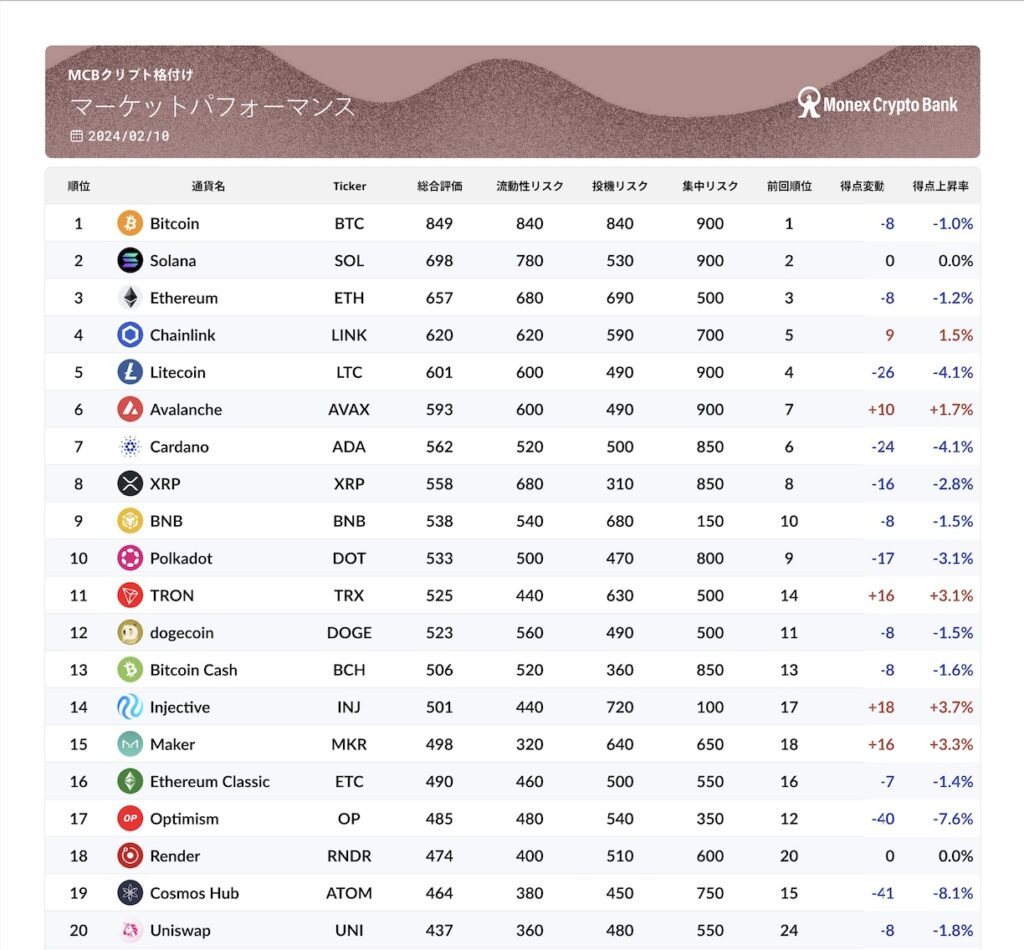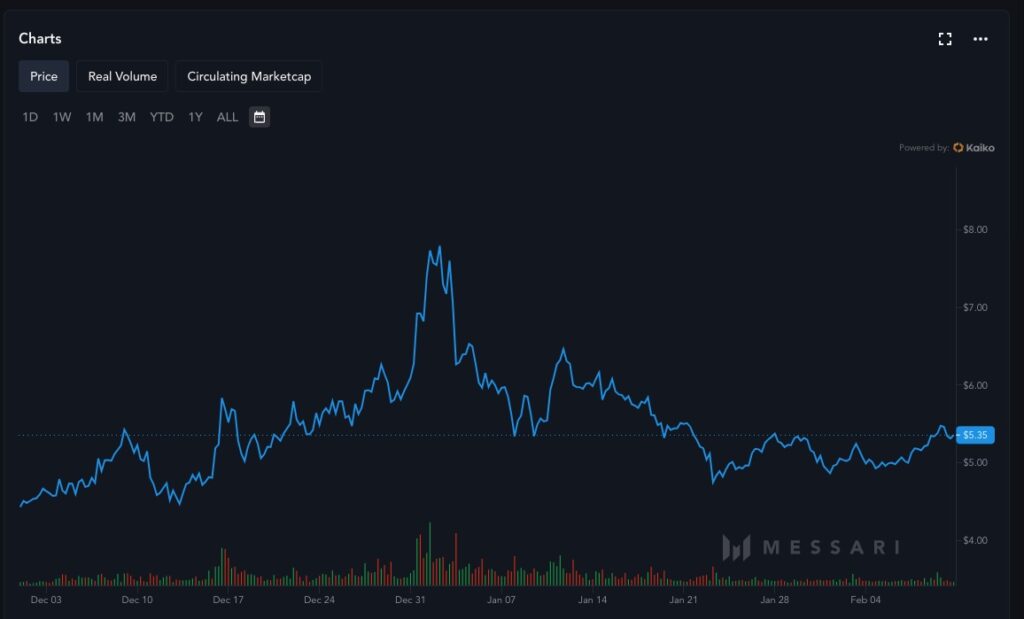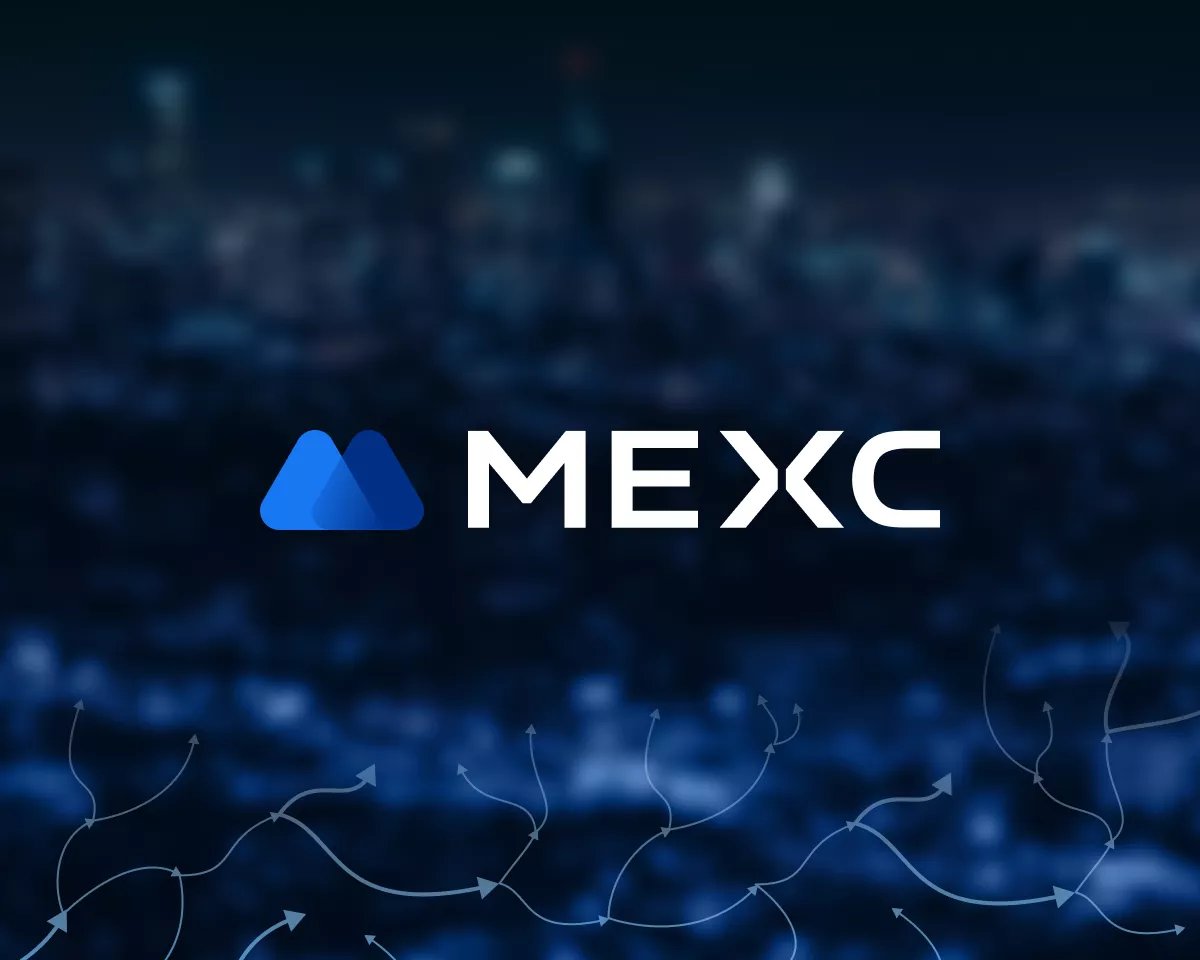
In January, the overall market price fell in mid-January due to the sale of GBTC, the Bitcoin spot ETF provided by Grayscale, but the pace of outflow slowed in February. In addition, on February 5th, it was reported that MicroStrategy bought Bitcoin in January in its financial results announcement, and that BlackRock and others' Bitcoin spot ETFs were advertised on Google, which became a hot topic. Perhaps because of this, the overall market price rose steadily, and finally on February 9th, BTCJPY reached the 7 million yen level.
The halving is finally around the corner, and the market is even more excited than it was at the beginning of the year. Let's take a look at the ratings for February, when there is a strong interest in future market trends.
First, let's check the trends of the top stocks. Bitcoin (BTC) received so much excitement due to the approval of spot ETFs in the US that its speculative risk increased, resulting in a slightly lower score. Solana (SOL), which overtook Ethereum (ETH) and took second place last time, remains in second place with 698 points, unchanged from last time. Due to the uproar over Bitcoin ETFs, it was expected that a physical ETF would be approved by the end of the year, and ETH, whose price has fluctuated more violently than BTC, has increased speculative risk just like BTC, resulting in a slightly lower score, widening the difference in score with SOL. The top 10 stocks remained unchanged from last time, but Chainlink (LINK), Avalanche (AVAX), and Binance Coin (BNB) each moved up one spot. LINK and AVAX both had improved liquidity ratings, and their overall scores increased by +9 and +10 points, respectively. On the other hand, although BNB's score dropped by 8 points from last time, Polkadot (DOT)'s drop was greater, so it ended up moving up in the rankings.
Injective (INJ) had the highest score of all stocks covered, with +18 points. Last time, it gained points due to lower speculative risk, but this time it increased its rating due to increased liquidity. This suggests that the company continues to maintain high liquidity.
On the other hand, the one with the lowest score was Decentraland (MANA), which is used on the Metaverse project Decentraland, with -52 points. The rating was significantly lowered due to increased liquidity risk and speculative risk. In fact, price growth slowed down at the beginning of the year, and has only started to recover since February. This time, there were many stocks with lower scores compared to last month, resulting in a drop of only one ranking.
The results showed that 5 stocks increased their scores compared to last month, 3 stocks remained unchanged, and 41 stocks decreased their scores. Much of this was due to a decline in valuations due to increased speculative risk. If the market as a whole increases, liquidity will increase, but if the market increases excessively, speculative risk may also increase. The results show that this is the case for many stocks.

 (Market Performance Rating dated February 10, 2024: Prepared by Manek Script Bank)
(Market Performance Rating dated February 10, 2024: Prepared by Manek Script Bank)Next, let's look at the important points for each item. First, there is liquidity risk. The overall market moved significantly from January to February, which led to an increase in the liquidity of the entire crypto market. As a result, there were only four stocks that recorded increases in liquidity to the point where their scores increased: LINK, AVAX, INJ, and ETC. Among them, INJ and AVAX increased their scores for the second consecutive time following last month. However, AVAX has seen a decline in network activity at the beginning of the month, resulting in a decline in trading volume. Although the price is on a recovery trend due to the market rally centered on BTC toward the end of the month, it is unclear whether it will continue to improve its score next month. The trading volume of INJ has also decreased slightly, and the rise in prices has come to a halt. It can be said that we have entered an adjustment phase.
Looking at the overall market movements over the past few days, it is predicted that only outstanding stocks that outperform the market will increase liquidity in March, just as they did this month. Check out the stocks with rising scores next month.
The four stocks that received higher ratings in terms of speculative risk are Tron (TRX), Maker (MKR), Bitcoin SV (BSV), and The Graph (GRT). In particular, TRX is a rare stock whose price has continued to rise since the beginning of the year. TRX has been attracting attention this year in the context of stablecoins and RWA (Real World Asset). Due to its high scalability and low fees, media reported that Tether, which issues the dollar-denominated stablecoin USDT, and Circle, which also issues USDC, are considering using TRX in their retail payment applications. . Tron Blockchain is also developing a protocol for RWA. The compatibility between stablecoins and RWA is very good, and together with other factors such as tokenomics and the existence of an active Dapps community, it is expected that this will lead to further growth, and the price is likely to rise. .
However, there is news that is dampening that momentum. The aforementioned Circle announced on its blog on February 20th that it would discontinue support for tokens on the TRON blockchain. The company only states that it is monitoring all chains, not just TRX, as part of its risk management, and does not give a detailed reason, but the reason behind this is a letter sent by a U.S. NPO to senators last year. There is. The letter calls into question the relationship between Tron Foundation, the de facto operating entity of TRX, which the SEC has named as an unregistered security, and Circle, which does business with many financial institutions. It would be natural to think that Circle, which had been looking for a timing to discontinue support in order to minimize compliance risks, has made this decision. Although it has provided very attractive returns since the beginning of the year, caution should be taken with TRX as it is still considered to have significant regulatory risks.
Concentration risk scores remained unchanged for most stocks. Meanwhile, Pepe Coin (PEPE), a meme coin that became a hot topic last year, dropped -100 points. PEPE hit a high around May last year, but after a pause in the rise, it has been going up and down repeatedly, and the price has continued to decline since the beginning of the year. Although it was in a downward trend as of the rating calculation date, it skyrocketed at the end of February as the market started to trend upward. This is an increase of nearly 100% compared to last month. The increasing concentration of PEPE raises concerns about further increases in speculative risk in the future. To begin with, meme coins are highly speculative. Speculative fever is reignited as the overall market rises, and the trading volume of PEPE is rapidly increasing. It must be said that it is dangerous to take this lightly. Along with TRX, this is also a stock to watch out for.

 (Source: Messari)
(Source: Messari)DePIN (Decentralized Physical Infrastructure Networks) stock is mentioned in various reports depicting the outlook for 2024. DePIN refers to a general project that aims to realize a physical resource adjustment and allocation mechanism using token incentives. Examples of physical resources include resources such as internet communications, computing resources, AI, and sensors. Stocks listed in Crypto Rating include Filecoin (FIL), Render Token (RNDR), Ghost Trader (GTR), and Akash Network (AKT). These stocks have continued to rise in price since the beginning of the year, even as other tokens have entered correction rounds, and have shown promising performance. Since the February rating reference date, trading volume has particularly increased, and prices have soared accordingly. I'm really looking forward to seeing what the ratings will be next month.
FIL is one of the oldest DePIN stocks. At one point, the price rose to $182, but it is currently below $10. FIL, which provides a decentralized file storage service, has the highest market capitalization among DePIN stocks and competes with centralized storage services provided by companies such as Google and Microsoft. Although it is currently at 27th place in the ranking, it can be expected to rise significantly if the price returns to its current level. In fact, with the rise in BTC at the end of February, the FIL market has also become bullish, and expectations are high as to how it will move in the future.
In 2024, keep an eye on DePIN stocks in general.
This rating highlights stocks that outperformed during the market boom at the beginning of the year. At the time of writing, the Nikkei Stock Average has reached a new high, and the crypto market, led by BTC, continues to rise at the same rate as at the beginning of the year. As of February 27th, BTC has entered the $50,000 range, with only $12,000 left to reach its all-time high. If you had been able to invest in the top 10 stocks last time, you would have returned +9.24% as of the February rating update date (weighted average by score ratio). If the recent market sentiment continues, we can expect a further rise in the next update in March. BTC's halving is approaching, and the market is volatile. As the yen continues to weaken, the strength of the crypto market is finally becoming clear to everyone. Please look forward to the next rating.
|Text/Image: Manec Script Bank
|Editing: CoinDesk JAPAN Editorial Department
The post Solana maintains 2nd place and widens the gap with Ether[ManekScript Bank Rating Report February]| CoinDesk JAPAN appeared first on Our Bitcoin News.

 1 year ago
128
1 year ago
128
![Will Stellar [XLM] drop to $0.378 after bearish breakdown?](https://ambcrypto.com/wp-content/uploads/2025/08/Evans-2025-08-18T135547.070-min.png)













 English (US) ·
English (US) ·